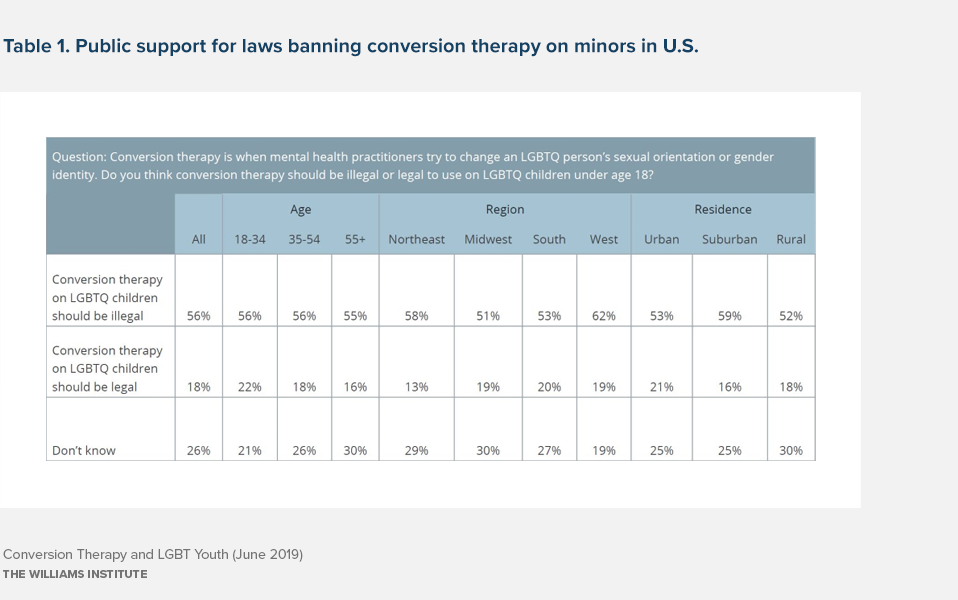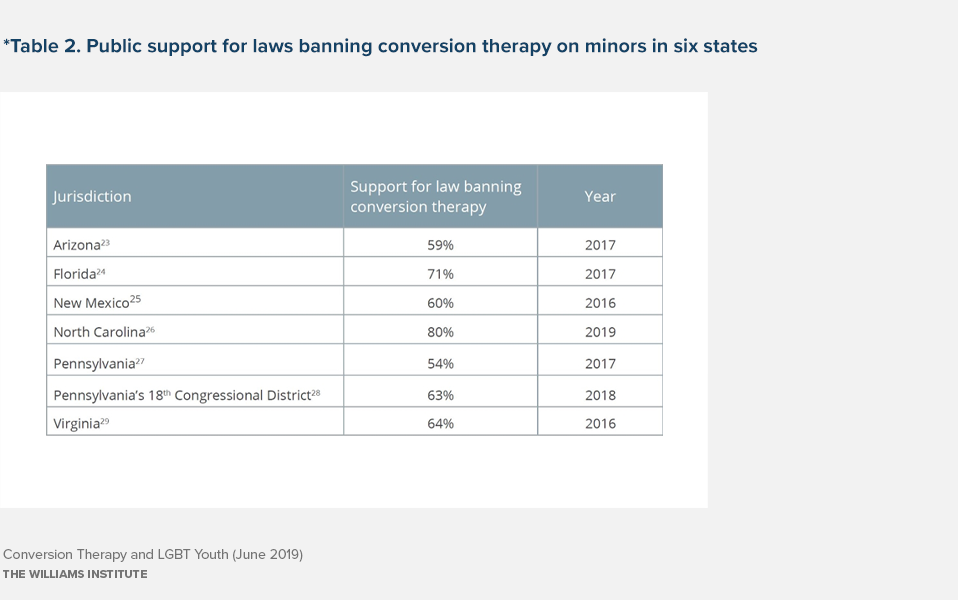Executive Summary
Conversion therapy, also known as sexual orientation or gender identity change efforts, is a practice grounded in the belief that being LGBT is abnormal. It is intended to change the sexual orientation, gender identity, or gender expression of LGBT people. Conversion therapy is practiced by some licensed professionals in the context of providing health care and by some clergy or other spiritual advisors in the context of religious practice. Efforts to change someone’s sexual orientation or gender identity are associated with poor mental health, including suicidality. As of June 2019, 18 states, the District of Columbia, and a number of localities have banned health care professionals from using conversion therapy on youth.
The Williams Institute estimates that:
- 698,000 LGBT adults (ages 18-59) in the U.S. have received conversion therapy, including about 350,000 LGBT adults who were subjected to the practice as adolescents.
- 16,000 LGBT youth (ages 13-17) will receive conversion therapy from a licensed health care professional before they reach the age of 18 in the 32 states that currently do not ban the practice.
- 10,000 LGBT youth (ages 13-17) live in states that ban conversion therapy and have been protected from receiving conversion therapy from a licensed health care professional before age 18.
- An estimated 57,000 youth (ages 13-17) across all states will receive conversion therapy from religious or spiritual advisors before they reach the age of 18.
This report updates conversion therapy estimates published by the Williams Institute in January 2018.
History
Conversion therapy has been practiced in the U.S. for over a century. Academic literature has documented instances of conversion therapy being used as early as the 1890s and continuing through the present day. Throughout the history of conversion therapy, a range of techniques have been used by both health care professionals and religious figures seeking to change people’s sexual orientation or gender identity. Currently, talk therapy is the most commonly used therapy technique. Some practitioners have also used “aversion treatments, such as inducing nausea, vomiting, or paralysis; providing electric shocks; or having the individual snap an elastic band around the wrist when the individual became aroused to same-sex erotic images or thoughts.” Other practitioners have used non-aversive techniques such as attempting to “change thought patterns by reframing desires, redirecting thoughts, or using hypnosis.”
An estimated 698,000 LGBT adults in the U.S have received conversion therapy either from a licensed professional or a religious advisor or from both at some point in their lives, including about 350,000 LGBT adults who received conversion therapy as adolescents.
Current Perspectives
Professional Health Associations
A number of prominent national professional health associations—including the American Medical Association, the American Psychological Association, and the American Academy of Pediatrics, among others—have issued public statements opposing the use of conversion therapy because it is harmful and ineffective. Several of these associations have called on Congress and state legislatures to pass laws that ban conversion therapy. For example, the CEO of the American Counseling Association (ACA) submitted testimony to the Illinois House and Senate in support of the state’s conversion therapy ban bill in 2015. In addition, ACA members sent 79 letters to the Governor and 84 letters to state legislators in support of the bill. Also, several professional health associations endorsed the Therapeutic Fraud Prevention Act, a federal bill that would have prohibited the practice of conversion therapy, including the National Association of School Psychologists, the American Psychoanalytic Association, the American Counseling Association, and the American Academy of Pediatrics.
Public Opinion
Public opinion polls at the national level and in several states have found majority support for ending the use of conversion therapy on youth. A 2019 national poll conducted by Ipsos/Reuters found that 56% of US adults support making conversion therapy on youth by mental health practitioners illegal as compared to a minority (18%) who think that it should be legal. Majority support for making conversion therapy on youth illegal was observed across all age groups, regions of the US, and rural/urban residence.

Data Source: Ipsos Poll Conducted for Reuters, Stonewall Anniversary Poll, June 6, 2019.
Recent polls in six states have also found strong support for laws that ban licensed health care professionals from using conversion therapy on youth.
Polling also indicates that many people do not think conversion therapy is effective; only 8% of respondents to a 2014 national poll said they thought conversion therapy could change a person’s sexual orientation from gay to straight.
Current Laws
Conversion Therapy by Licensed Health Care Professionals
As of June 2019, 18 states and the District of Columbia had passed statutes limiting the use of conversion therapy: California, Colorado, Connecticut, Delaware, D.C., Hawaii, Illinois, Maine, Maryland, Massachusetts, Nevada, New Hampshire, New Jersey, New Mexico, New York, Oregon, Rhode Island, Vermont, and Washington. The laws protect youth under age 18 from receiving conversion therapy from licensed mental health care providers. California was the first state to pass a conversion therapy ban in 2012. Four states—Colorado, Maine, Massachusetts, and New York—passed bans in 2019. In addition, a number of cities and counties in states without statewide bans have passed bans at the local level.
All of the state statutory bans allow licensing entities to discipline health care providers who use conversion therapy on youth under age 18. Under Connecticut, Illinois, and New Hampshire laws, the use of conversion therapy on youth is also considered an unfair business practice, and the laws allow for enforcement and penalties consistent with other state laws against such practices. In addition, in 2015, a New Jersey court held that providing conversion therapy in exchange for payment constitutes a fraudulent business practice, regardless of whether it is used on youth or adults.
16,000 LGBT youth (ages 13-17) will receive conversion therapy from a licensed health care professional before they reach the age of 18 in the 32 states that currently do not ban the practice, unless additional states pass conversion therapy bans. Approximately 10,000 LGBT youth (ages 13-17) who live in states with bans have been protected from receiving conversion therapy from a licensed health care professional before age 18 because their states have banned the practice.
In addition to state bans, members of Congress have introduced federal legislation aimed at limiting conversion therapy. The Therapeutic Fraud Prevention Act, introduced in both the House and Senate in 2017 and 2015, would have classified conversion therapy provided in exchange for payment as a form of consumer fraud. The law would have allowed state attorneys general and the Federal Trade Commission to bring enforcement actions against individuals who are providing conversion therapy for payment or advertising such services. Additionally, the Prohibition of Medicaid Funding for Conversion Therapy Act and the Every Child Deserves a Family Act would limit the practice of conversion therapy by prohibiting payments under the Medicaid and Social Security programs for conversion therapy. Both of these bills have been introduced in Congress in 2019.
Conversion Therapy by Religious and Spiritual Advisors
The state statutory conversion therapy bans apply to licensed mental health care professionals and sometimes more broadly to others who seek to provide conversion therapy in exchange for payment. The laws generally do not apply to religious or spiritual advisors who engage in sexual orientation or gender identity change efforts within their pastoral or religious capacities.
These exclusions for therapy provided by religious or spiritual advisors leave many youth vulnerable to conversion therapy even in states with bans. An estimated 57,000 youth (ages 13-17) across all states will receive conversion therapy from religious or spiritual advisors before they reach the age of 18. This includes approximately 38,000 youth (ages 13-17) who will receive conversion therapy from religious or spiritual advisors, but not a licensed health care professional before they reach the age of 18. Some youth will receive conversion therapy from both a licensed health care provider and a religious or spiritual advisor before they reach age 18.
Conclusion
Conversion therapy continues to be used in the U.S. despite support for ending the practice among prominent medical and mental health associations and the public. An estimated 698,000 LGBT adults in the U.S. have received treatment to change their sexual orientation or gender identity at some point in their lives, including about 350,000 who received treatment as adolescents. As of June 2019, 18 states, the District of Columbia, and a number of localities had enacted laws banning licensed professionals from using conversion therapy on youth. An estimated 16,000 LGBT youth will receive conversion therapy from a licensed professional before they reach the age of 18 in the 32 states that currently do not ban the practice. In addition, an estimated 57,000 LGBT youth across all states will receive conversion therapy from religious or spiritual advisors. Because of the large number of youth who may be vulnerable to conversion therapy, individuals who have contact with minors should be aware that the American Psychological Association has issued a resolution “advising parents, guardians, young people, and their families to avoid sexual orientation change efforts that portray homosexuality as a mental illness or developmental disorder and to seek psychotherapy, social support and educational services that provide accurate information on sexual orientation and sexuality, increase family and school support, and reduce rejection of sexual minority youth[.]”
Download the brief

